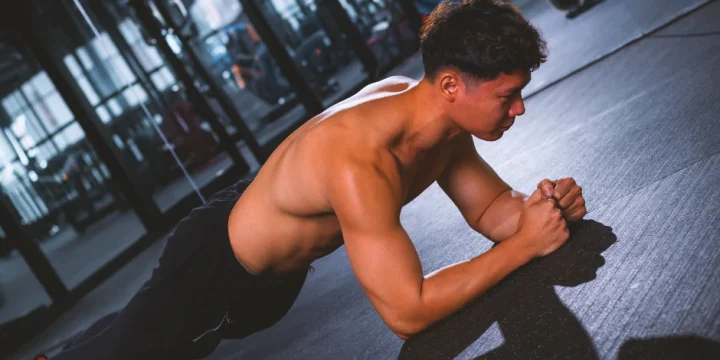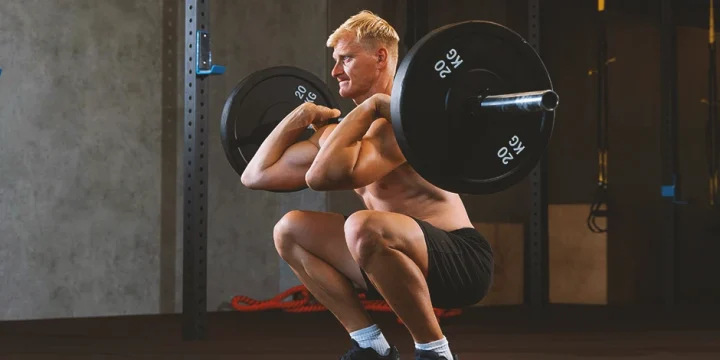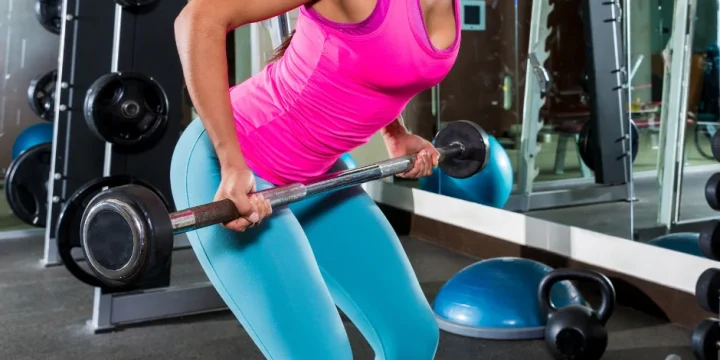As a personal trainer, I have worked with quite a few people who spent a lot of time bulking up their biceps and triceps but ended up with shoulders that aren't even in size.
Isolating the anterior deltoids seems to be something commonly overlooked, which is why we decided to put together a list of the best exercises to target these muscle groups.
The best part is that you will only need to pick 3 or 4 of them for your arm and shoulder days to start seeing a difference.
So, let me show you the best way to target the front deltoids.
Quick Summary
- The best front delt exercises range from front raise, shoulder press, military press, Arnold press, shrugs, lateral raises, and front cable raises, among others.
- Military press, front raises, front cable raise, and standing dumbbell row are among the beginner-friendly front delt exercises.
- Consistency in front-delt exercises and a healthy diet can help blow up your shoulders in months.
- Start with a small number of sets on the selected exercises and progressively increase.
Our Top Front Delt Exercises
The first thing I’d say is that you shouldn’t do all of these exercises as one single routine. It wouldn’t be the best idea to isolate one area in this way for most people.
So, aim to pick 3 or 4 exercises and add them to your arms and shoulders training days as needed.
Here’s the first one.
1. Front Raises

Front raises are the go-to exercise for targeting your delts, and if there’s only time for one of these movements in your routine, then choose this one.
There are three ways I suggest you do these.
My favorite is to stand tall with your feet about shoulder-width apart. Grab a hold of an Olympic weight plate and hold it with both hands at about hip-high.
Slowly lift the plate up to about shoulder height while keeping your arms straight.
At the top of each rep, hold the plate for 1 or 2 seconds and then slowly release it back to the starting position.
The second option is similar, but you start off with a dumbbell in each hand next to your body. You can either lift the dumbbells simultaneously or one at a time, but if you want to make the exercise more effective, I’d recommend lifting them at the same time.
Finally, try to do the dumbbell raises while sitting on a workout bench with the backrest at a 30% angle. I find that this activates your front delt muscles a lot more effectively.
Read More: How To Get Wide Shoulders?
2. Shoulder Press
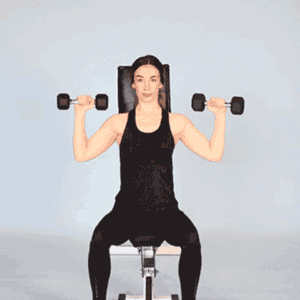 Set up your bench with the backrest in a near-vertical position, and then grab onto one dumbbell in each hand. Lift your hands to about head-high with your palms facing forward and your elbows at a right angle.
Set up your bench with the backrest in a near-vertical position, and then grab onto one dumbbell in each hand. Lift your hands to about head-high with your palms facing forward and your elbows at a right angle.
Avoid having the dumbbells right above your shoulders, as this can add strain to your rotator cuffs.
Push the weights up slowly and then return to the starting posture for 3 sets of 8 to 10 reps.
You also have two alternatives to this.
One option is to use a barbell, which many athletes do when they reach higher weight ranges.
You can also do this exercise standing up, which would engage your core along with your front delts, as your body will need to work more to stay balanced.
3. Military Press
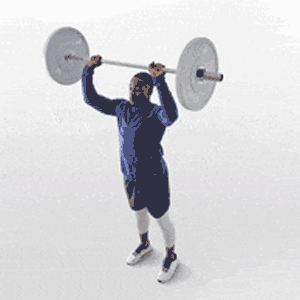
The military press is something I’d only suggest if you’ve become used to the shoulder bench press, as it’s a slightly more difficult type of overhead press.
Start the overhead press in a standing position with your feet about hip-wide apart.
Hold each dumbbell at about shoulder height and shoulder width, but this time, you want to keep your elbows more in front of you rather than to the side.
Your palms will be facing each other, and from here, you start the upward push until both arms are fully extended.
Then, slowly lower the dumbbells and repeat for 8 reps over 3 sets.
You should find that the narrower your overhead press stance is, the more your core muscles will engage as your body fights to maintain its balance.
And if you are not a fan of weights, you can do this exercise using resistance bands.
4. Arnold Press
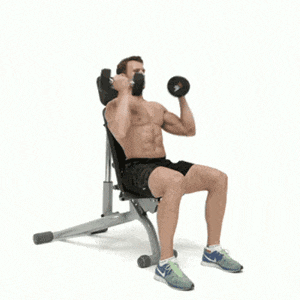 The Arnold press is another variation of the shoulder bench press that activates more muscle groups around your shoulders through the introduction of more arm rotation.
The Arnold press is another variation of the shoulder bench press that activates more muscle groups around your shoulders through the introduction of more arm rotation.
Start in a standing position with a dumbbell in each hand as if you were at the top of a regular biceps curl.
As you start to press your arms up, turn your elbows outward. At about the halfway point, your palms should be facing forward, and you continue to a fully extended position.
Keep in mind that if you want to increase the weight load, then you might be more comfortable on a bench.

5. Standing Dumbbell Row
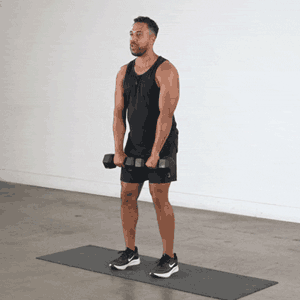
While it looks like a simple movement, it’s important to get the setup right to avoid unnecessary shoulder strain and injuries [1].
Choose either a barbell or two dumbbells and lift them up into a standing position. Your palms should face your body, and the weights should be about hip-high.
Your hands also need to remain a bit more than shoulder-width apart, which is easier to achieve with a barbell.
Pull up the weight in a slow and steady motion until you reach about chest-height, allowing your elbows to flare out to the side.
On the return, make sure that you don’t allow the weight to “drop,” as this can damage your shoulder joint and elbows.
“Deltoid strains can be caused by numerous mechanisms. Most commonly, they result from overuse of the muscle without adequate rest. This can lead to discomfort in the area of the deltoid muscle with associated swelling and loss of function.”
- Brian J. Ludwig, MD, & writer at SportsMD.com.
6. Shrugs
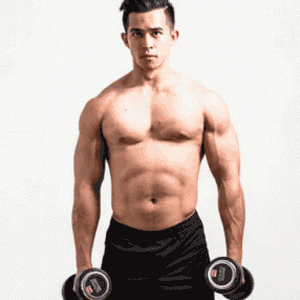 The easiest way to start is with dumbbells held in each hand beside your body. You pull your shoulders up and slightly back while holding the squeeze at the top.
The easiest way to start is with dumbbells held in each hand beside your body. You pull your shoulders up and slightly back while holding the squeeze at the top.
To activate the anterior deltoids a bit more, you’ll also want to lift your hands up a little, allowing your elbows to bend.
Some of my clients find this easier with a barbell. What the barbell also does is position your arms slightly in front of your body, which tends to engage the front delt muscle a bit easier.
Other types of exercises:
7. Lateral Raises
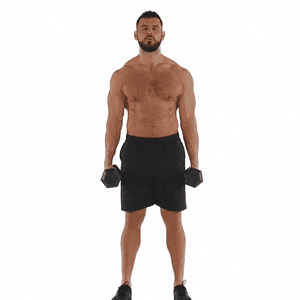
Stand tall with the dumbbells hanging down to the side of your body and the palms faced towards your thighs.
Avoid rounding out your back. Start the movement by pulling up your arms in a wing-like motion until you reach about shoulder-height.
You should feel this in your front delts, traps, and upper back area as well, giving you a solid compound exercise.
While you only want to do about 8 reps in each of 3 sets, make sure that you can raise the dumbbells to the top for all of them.
Also Read: Best Lateral Head Tricep Exercises
8. Decline Push-Ups
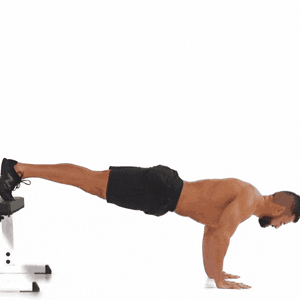 One way to do these is to get into a downward dog position. While keeping your legs perfectly straight, bend your elbows to allow your upper body to lower down towards the ground.
One way to do these is to get into a downward dog position. While keeping your legs perfectly straight, bend your elbows to allow your upper body to lower down towards the ground.
From there, push back up to complete the movement in the starting posture to improve your shoulder flexion.
An alternative is to put your feet on top of a bench so that you’re in a downward-facing push-up position. Ideally, your upper chest should be slightly lower than your ankles to force more pressure on your front deltoid muscles [2].
9. Front Cable Raise
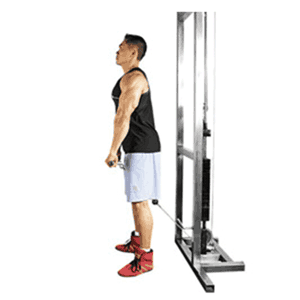
Set up a cable machine with the appropriate weight and a short, straight handle.
Start with a pronated grip, your arms straight and pointing down at a slight angle to your body.
From here, slowly pull your arms up until they reach a horizontal position and hold it for a second.
Then, slowly lower your arms to the starting posture of the movement.
One tip I give my clients is to count to 3 on the way up and again on the way back down, as this is not an exercise that is about speed.
10. EZ Bar Press
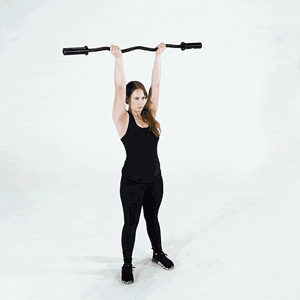 First, make sure you set your incline bench to fully vertical. Your starting position is sitting upright with the center of the EZ bar right under your chin.
First, make sure you set your incline bench to fully vertical. Your starting position is sitting upright with the center of the EZ bar right under your chin.
Your elbows should be facing outwards and your palms forward, and then you push up the bar until your arms are fully stretched above your head.
Here’s the tricky part.
You’ll need to move your head out of the way on the way up and down. As you push up, tilt your head back and then look straight forward again. On the way back down, tilt it back again until the bar reaches your chin.
Injury Prevention and Safe Practice Tips
Injury prevention is crucial in front delt exercises, especially for those with prior shoulder issues.
Start with a thorough warm-up to prepare the muscles and joints. Maintain proper form: keep elbows slightly bent and avoid overextending.
Gradually increase weights to prevent strain. Incorporate rest days to allow muscle recovery. Listen to your body; if an exercise causes pain, stop immediately.
Strengthening surrounding muscles, like the rotator cuff, can provide additional support.
Research from the Movement and Training Science, Leipzig University, has revealed that implementing prevention strategies for overhead exercises can significantly limit shoulder injuries [3]. And in my experience as a personal trainer, I can confirm that a careful and gradual approach to weight increases can strengthen the joint and limit injury risks.
References:
- https://www.menshealth.com/fitness/a19531264/deltoid-muscle-strain-front/
- https://www.physio-pedia.com/Deltoid
- https://pubmed.ncbi.nlm.nih.gov/34560586/
About The Author
You May Also Like

